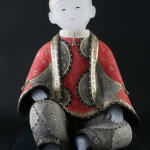Vivian wang China, b. 1945
Festival, 2023, SOLD
Cast glass, stoneware, gold leaf, crystal gemstones
26"H x 16"W x 16"D
Copyright The Artist
Further images
“Festival” portrays a very young boy in the style of a Gosho Doll. The inspiration for this piece came from the Gosho dolls made during the Edo Period of Japan...
“Festival” portrays a very young boy in the style of a Gosho Doll. The inspiration for this piece came from the Gosho dolls made during the Edo Period of Japan (1603-1867), a time when the arts flourished. They were never meant to be played with. Instead, they were placed in a significant area of the home and displayed as a work of art. The dolls were highly prized and given as gifts among members of the court during the Edo Period.
Gosho Dolls were fashioned as very young, chubby boys with round heads, a sweet expression on their faces and an extremely white complexion (made of paste from ground oyster shells in ancient times). This particular doll, “Festival,” had been designed for the Kanda Festival, one of the three biggest festivals in Japan during the 17th, 18th and 19th centuries and still celebrated today. He is shown wearing an elaborate red and gold costume. The color red symbolizes the peace and prosperity of the family. The gold represents wealth and power.
Gosho Dolls were fashioned as very young, chubby boys with round heads, a sweet expression on their faces and an extremely white complexion (made of paste from ground oyster shells in ancient times). This particular doll, “Festival,” had been designed for the Kanda Festival, one of the three biggest festivals in Japan during the 17th, 18th and 19th centuries and still celebrated today. He is shown wearing an elaborate red and gold costume. The color red symbolizes the peace and prosperity of the family. The gold represents wealth and power.








